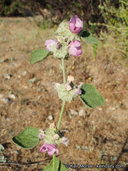Taxon Report
Malacothamnus astrotentaculatus K. Morsestarry-tentacled bushmallow |
 © 2023 Keir Morse |
Taxon Summary
Malacothamnus astrotentaculatus, commonly known as starry-tentacled bushmallow, is a perennial deciduous shrub in the Malvaceae that is found only in California. It occurs within Chaparral, Cismontane woodland, and Riparian woodland, growing at elevations from 285 to 1455 meters. Malacothamnus astrotentaculatus is ranked 1B.3, Plants Rare, Threatened or Endangered in California and Elsewhere; Not very threatened in California.Classification
|
Scientific Name: |
Malacothamnus astrotentaculatus K. Morse |
|
Common Name: |
starry-tentacled bushmallow |
| Family: | Malvaceae |
| Element Code: | PDMAL0Q0R0 |
| USDA Plants Symbol: | |
|
Synonyms/Other Names: |
|
Ecology and Life History
| Lifeform: | perennial deciduous shrub |
| Blooming Period: Jun-Jul(Aug-Sep) | Jun-Jul(Aug-Sep) |
| Elevation: | 285-1455 (935-4775) |
| General Habitats: | Chaparral, Cismontane woodland, Riparian woodland |
| Microhabitat: | Burned areas |
| Microhabitat Details: |
Conservation Status
| CA Rare Plant Rank: | 1B.3 |
| Global Rank: | G2 |
|
State Rank: |
S2 |
| State List: | None |
| Fed List: | None |
| Other Status: | BLM_S |
|
CRPR Changes: |
|
Occurrence Data from the CNDDB
| Total Occurrences: | 13 |
| Element Occurrence Ranks: | |
| Excellent (A) | 0 |
| Good (B) | 0 |
| Fair (C) | 0 |
| Poor (D) | 1 |
| None (X) | 0 |
| Unknown (U) | 12 |
| California Endemic: True | |
| California Counties and Islands: Name (Code) | |
| Shasta (SHA), Tehama (TEH) | |
| Quads: Name (Quad Code) | |
| Arbuckle Mtn. (4012247), Beegum (4012237), Bollibokka Mtn. (4012282), Chanchelulla Peak (4012248), Chickabally Mtn. (4012236), Hanland Peak (4012283), Lamoine (4012284), North Yolla Bolly (4012228), O'Brien (4012273), Ono (4012245), Platina (4012238), Pony Buck Peak (4012331), Tar Bully (4012246), Wildwood (4012341) | |
Threat List Data from the CNDDB
| Threat List Total: | 2 | |
| EOs with Threat Listed: | Total EOs | % of EOs |
| 1 | 8 % | |
| Biocides | 1 | 7% |
| Logging | 1 | 7% |
Notes
|
Threats: |
| Potentially threatened by herbicides, alteration of fire regimes, and fire suppression. |
|
Taxonomy: |
| Differentiated from other Malacothamnus taxa by its geographic range and the unique combination of the following morphological characters: spike-like inflorescences, linear calyx bracts, and calyx lobes that are much wider above bases than at bases. Also genetically distinct. |
Selected References
| Proposed addition to CRPR 1B.3, G2 / S2 (2024) |
| Malacothamnus 2: 65–69 (2023) |
| Malacothamnus 3 (2023) |
Citation
California Native Plant Society, Rare Plant Program. 2025. Rare Plant Inventory (online edition, v9.5.1). Website https://www.rareplants.cnps.org [accessed 13 December 2025].